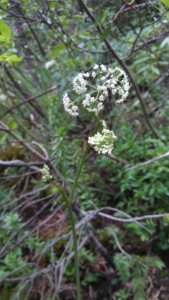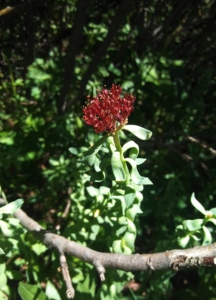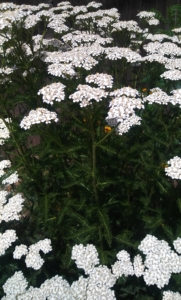When you think of medicine do you think of fresh mountain air and cool glacier fed streams? A refreshing breeze rustling the aspen leaves wafting the scent of pine with just a hint of vanilla, while lazy fluffy white clouds drift past rocky peaks. Or, is medicine fluorescent lights, an antiseptic tang in the air; a chemical based world of drugs and pharmacy? In the modern world of steel and glass high rises, cement and asphalt paved ground, it is easy to forget that only a couple generations ago the rainbow of flowers poking through the high mountain grass, the verdant world of grasses, trees and bushes, was the only medicine that has sustained us since the dawn of human existence.
This weekend the American Institute of Integrative Herbalism (AIIH) held our 3rd annual Colorado Mountain Medicinal Plant Field Study where we reconnected with the medicinal plants that grow in the mountains of our beautiful state. Students, clinicians and artists gathered in the picturesque Rocky Mountains to learn how the plants that grow all around us can be used for health and healing. In this modern world of surgery and biomedicine it is easy to forget that nearly 70%-80% of new drugs come from plants, but as you’re walking through the high mountain meadows, hearing each plant’s medicinal benefits, it is impossible to ignore each drop of color holding the whisper of medicine and the promise of health. Every day we encounter herbs that can be used to help many common ailments and here are just 4 of the highlights from this past weekend.
ARNICA
Many of us are familiar with this herb, and you may already be slapping on some Arnica gel or liniment to treat your sore, bruised and achey muscles and joints. Most of us however, don’t know that this beautiful yellow flower grows all over the Rocky Mountains. Like a burst of sunshine poking through the green underbrush, this powerful little plant has long been used topically for traumatic injuries and poor circulation. Infused into oil or alcohol some caution is needed when using this herb as it has some toxicity, and should never be applied to open wounds or taken internally.
VALERIAN
Well kno wn for helping us sleep, this plant is another common one that grows throughout much of North America. The root is the main part of the plant that is used. Having a unique, musky scent that some say is reminiscent of sweaty gym socks, it is immediately obvious when harvesting this plant that it contains strong, albeit pungent, medicine. While Valerian is deserved of its reputation as an herb to help sleep, some may find that it has the opposite effect and does not relax them at all. The reason for this, according to Chinese Herbal theory, is that Valerian is a “warming” herb and should not be used when someone has a warm constitution. Signs of warmth, or heat, in the body may include high blood pressure, acid reflux, easily red flushed skin and face, red eyes, generally feeling hot all the time, dry mouth and thirst, a bitter taste in the mouth and being easily irritated and angry. That means, if you have some or all of these symptoms it is best to consult with an experienced herbalist before using Valerian. However, more than just being an herb for insomnia Valerian has a long history of usage to treat joint pain, bruising, digestive pain and diarrhea.
wn for helping us sleep, this plant is another common one that grows throughout much of North America. The root is the main part of the plant that is used. Having a unique, musky scent that some say is reminiscent of sweaty gym socks, it is immediately obvious when harvesting this plant that it contains strong, albeit pungent, medicine. While Valerian is deserved of its reputation as an herb to help sleep, some may find that it has the opposite effect and does not relax them at all. The reason for this, according to Chinese Herbal theory, is that Valerian is a “warming” herb and should not be used when someone has a warm constitution. Signs of warmth, or heat, in the body may include high blood pressure, acid reflux, easily red flushed skin and face, red eyes, generally feeling hot all the time, dry mouth and thirst, a bitter taste in the mouth and being easily irritated and angry. That means, if you have some or all of these symptoms it is best to consult with an experienced herbalist before using Valerian. However, more than just being an herb for insomnia Valerian has a long history of usage to treat joint pain, bruising, digestive pain and diarrhea.
RHODIOLA
Perhaps not as well known, this plant has recently gained popularity because of its ability to help adjust to high altitude environments and improve exercise performance. The species of Rhodiola that has been most studied is one that grows in Tibet, Mongolia and Siberia, but other species have been used extensively throughout Scandinavia and Europe as well. The Colorado species is quite similar to all of these and could potentially be used for a similar purpose. Aside from increasing oxygenation in the blood, it has also been shown to have positive effects on stress and cortisol levels, In some studies it has even been shown to be helpful in mental health conditions such as depression.
YARROW
 This plant grows all over the Northern Hemisphere of the world and has been used as medicine in nearly every culture since the beginning of human existence. Fossilized yarrow has been found in caves of Neanderthals dating back 40,000-60,000 years ago, and the latin name for yarrow, Achillea millefolium, is named after the Greek hero Achilles where legend says he learned of it from the ancient Greek healer Chiron, and used it to heal his soldiers during the Trojan War. Fortunately, this feather-leafed, white topped plant is ubiquitous in Colorado and perhaps one of our best local medicinals. An herb with many uses, it can help stop bleeding when applied topically, assist in sweating out a respiratory infection in the initial stages, relieve the pain of gas and indigestion in digestive upset, soothe menstrual cramps, ease pain and cramping in muscles and joints when applied topically and even calm symptoms associated with stress and depression. Truly if one were to only know one plant that grows in our beautiful Colorado mountains this would be it!
This plant grows all over the Northern Hemisphere of the world and has been used as medicine in nearly every culture since the beginning of human existence. Fossilized yarrow has been found in caves of Neanderthals dating back 40,000-60,000 years ago, and the latin name for yarrow, Achillea millefolium, is named after the Greek hero Achilles where legend says he learned of it from the ancient Greek healer Chiron, and used it to heal his soldiers during the Trojan War. Fortunately, this feather-leafed, white topped plant is ubiquitous in Colorado and perhaps one of our best local medicinals. An herb with many uses, it can help stop bleeding when applied topically, assist in sweating out a respiratory infection in the initial stages, relieve the pain of gas and indigestion in digestive upset, soothe menstrual cramps, ease pain and cramping in muscles and joints when applied topically and even calm symptoms associated with stress and depression. Truly if one were to only know one plant that grows in our beautiful Colorado mountains this would be it!
So, next time you take a hike, or even if you’re just walking around your local neighborhood or backyard, take a look at the plants growing all around you and know that many, if not most, of those plants may be edible or medicinal in some way. Of course, this article is not intended to give any medical advice, and please seek the advice of a trained herbalist before taking any herbal medicines you are unfamiliar with. This is especially true before you go harvesting plants in the wild, as one should always educate themselves on sustainable harvesting practices before collecting any plants in the wild. However, all of us could benefit from knowing how to use the plants that grow all around us, so seek out the aid of your local herbalist, or join us on a plant walk outside and experience the bounty the natural world has to offer.
